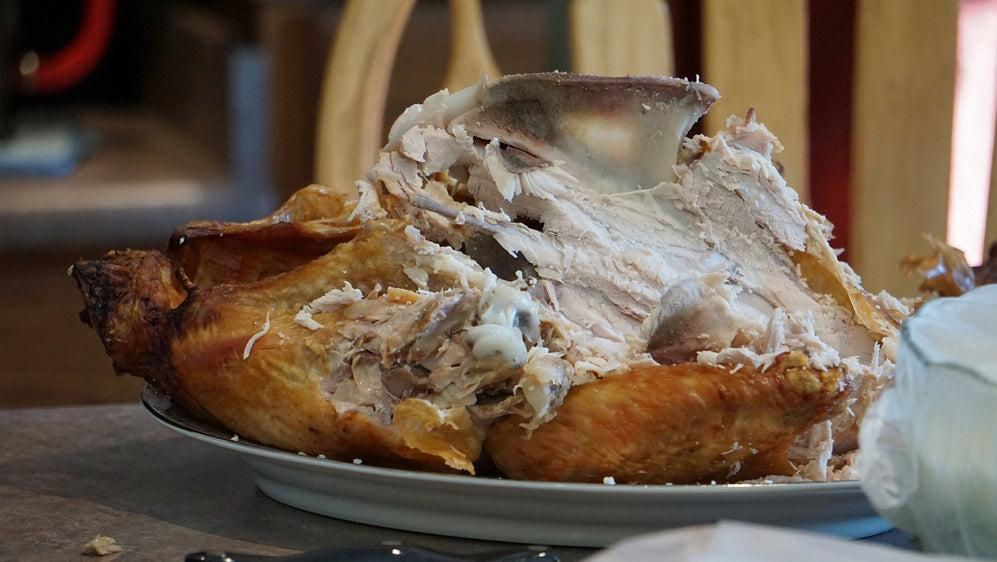Turn Your Thanksgiving Turkey Carcass Into Homemade Stock
It's easy, reduces food waste, and brings way more flavor to everything you cook.
If you host Thanksgiving, or Friendsgiving, or somehow end up with any sizable chunk of a turkey carcass this year, you might be in the habit of tossing the bones after the meal is over. However, it's super easy to make a quick stock out of your sacrificial fowl. You can do this with chicken as well, but who's thinking about chicken this time of year? Here's how it's done.
Why you should make stock from Thanksgiving turkey bones
You can use stock for any number of things during the rest of the winter months. If you make soup, chili, or sauce, you can use it in place of store-bought broth, stock, or water. I use it in place of water when making rice or risotto for added richness.
If you get COVID again and can't eat solids, you can sip on the stock until you feel better. If you want to jump on the bone broth craze several years too late, you can do it on the cheap with leftover turkey bones.
I don't really differentiate between stock and broth in my household when cooking, but technically broth is made primarily from vegetables while stock is made from bones, like those of livestock. In recipes, I use them interchangeably unless I'm having vegetarians or vegans over, and you can too.
How to make a post-Thanksgiving turkey stock
I am lazy and tired after these large food-based social gatherings, to say nothing of the effects of tryptophan, so I don't want to do another cooking task as soon as the guests leave. My preferred method for making stock is as easy as possible. Here are the tools you'll need:
- Slow cooker
- Colander (metal mesh is best)
- Ladle
- Heatproof bowl or glass measuring cups (I like the large 4-cup one for this)
- Oven mitts
- Grilling tongs
- Freezer-safe containers
The process is as follows:
- Remove as much meat as possible from the turkey and store separately for leftovers. (If there were vegetables or herbs used in cooking the turkey, hang onto those.)
- Place as much of the carcass as possible, along with any remaining herbs and vegetables (onions, celery, carrots), into your slow cooker. Cover the bones with water, but be careful not to go over the fill line. Turn the slow cooker on low.
- Go to bed and reassure yourself that you don't have (spoiler alert) the Crock-Pot from This Is Us.
- Wake up to a house that smells delightfully like turkey fat. Turn off the slow cooker and let it cool for a few minutes—but not too long, for food safety reasons.
- Using grilling tongs, remove as many of the bones and other solids as you can and discard.
- Place a colander over a heatproof bowl and begin ladling the stock from the Crock-Pot into the colander so it separates out any remaining bones or solids. If you have a lot of vegetables in your stock, some people like to squish them in the colander to get more vegetable and spice content into the liquid.
- When the heatproof bowl under the colander is full, pour the stock into a freezer-safe container, then return the empty bowl underneath the colander and continue ladling and straining the liquid from the Crock-Pot.
- Continue ladling the liquid and discarding the solids until there's nothing left in your slow cooker. You may need to use the oven mitts to lift the bowl of the slow cooker out of the base and pour the last bits of stock through the colander.
- You can freeze the stock immediately or refrigerate it until the fat rises to the surface, then scrape the fat off the stop with a spoon and discard. I don't usually do this because turkey doesn't produce a ton of fat during this phase. Usually it only produces a thin layer on the top, and since "fat is flavor," it usually makes for better tasting recipes later. Whatever you do, don't try to skim off the fat with one of these things.
Variations on turkey stock
If you don't have a slow cooker, there are stove top variations of this same method, but you'll need to remain present during the cooking process so you don't burn the house down. (Most pressure cookers and Instant Pots also have a "slow cooker" setting, which works the same as the Crock-Pot.)
If you have a particularly small slow cooker or a particularly large turkey, you can make the stock in two rounds. Make sure to refrigerate any flesh when it's not in use, and make it a habit to keep a stock bag in your freezer so you can replicate the flavors year-round.
You can store the stock in jars like they do at the grocery store, but if you go that route you'll need to follow canning safety procedures, and that takes away from the simplicity of the recipe. I just keep the finished stock in the fridge and use within several days. If you choose to freeze your stock for future use, don't use a typical pickling or canning jar, because they'll crack. I usually use thick glass containers specifically made for freezing, and you can use plastic quart containers too. To use frozen stock, thaw it out in the refrigerator a day before you want to use it, or use the defrost setting on your microwave the day of.
